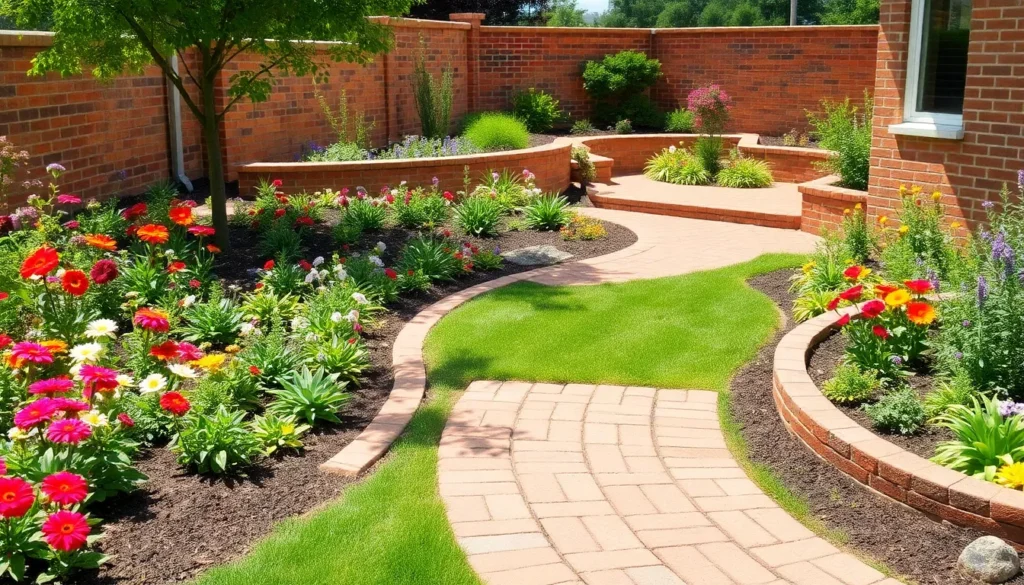Table of Contents
ToggleWhen it comes to landscaping, bricks are like the Swiss Army knife of outdoor design. They’re versatile, durable, and can turn a bland yard into a stunning oasis quicker than you can say “garden gnome.” Whether it’s creating a charming path, a sturdy wall, or a cozy patio, bricks have got your back. Plus, they come in various colors and textures, so you can unleash your inner artist without breaking a sweat.
Imagine hosting a barbecue on a beautiful brick patio while your friends marvel at your landscaping genius. With the right bricks, you’re not just building; you’re crafting an outdoor masterpiece. So grab your gloves and let’s dive into the world of bricks for landscaping—where creativity meets practicality, and every project is just a few bricks away from perfection.
Benefits Of Using Bricks For Landscaping
Bricks offer numerous advantages for landscaping projects. Their remarkable qualities make them a top choice for outdoor design.
Durability And Strength
Bricks withstand extreme weather conditions, ensuring long-lasting structures. Their resistance to moisture and heat prevents cracking and fading over time. High compressive strength allows bricks to support significant weight, making them ideal for various applications. Landscapers frequently use bricks for retaining walls and patios, where stability is essential. Additionally, the low maintenance requirements mean fewer repairs, allowing for more enjoyment of the outdoor space.
Aesthetic Appeal
Bricks come in diverse colors, textures, and shapes, enhancing the visual interest of any landscape. The natural appearance complements various design styles, from rustic to contemporary. The versatility of bricks allows for creative patterns and arrangements, adding character and uniqueness to patios, pathways, and walls. Landscapers can mix and match brick types to achieve striking designs, which create inviting outdoor areas. Incorporating bricks adds sophistication and charm, ensuring the landscape stands out.
Types Of Bricks Suitable For Landscaping

Bricks come in various types, each offering unique advantages for landscaping projects. Understanding these options aids in selecting the right bricks for specific needs.
Clay Bricks
Clay bricks stand out due to their natural, earthy look. These bricks are baked at high temperatures, resulting in exceptional durability and strength. They resist weathering and can handle extreme heat and moisture. Various colors and shapes enhance their versatility, allowing for intricate designs in patios and walkways. Garden beds benefit from their aesthetic appeal, as clay bricks complement greenery effortlessly.
Concrete Bricks
Concrete bricks, made from cement and aggregates, offer impressive strength and low maintenance features. These bricks are perfect for constructing retaining walls and pathways due to their ability to withstand heavy loads. Homeowners value the range of colors and textures available in concrete bricks, ensuring creative landscaping solutions. Their affordability makes them a popular choice among budget-conscious landscapers. Additionally, concrete bricks are easy to work with, facilitating multiple design layouts.
Reclaimed Bricks
Reclaimed bricks provide a rustic charm that enhances outdoor spaces. Sourced from old buildings, these bricks offer unique colors and textures, contributing to a vintage aesthetic. Their eco-friendly nature appeals to environmentally conscious homeowners. Reclaimed bricks also demonstrate strength and durability, having withstood years of use. Designers appreciate the stories behind these bricks, adding character to landscapes while promoting sustainability. Gardens adorned with reclaimed bricks become focal points, showcasing individuality and creativity.
Creative Ways To Use Bricks In Landscaping
Bricks provide a myriad of options for enhancing outdoor spaces. Creative landscaping design incorporates bricks in various innovative ways.
Pathways And Walkways
Bricks form elegant pathways and walkways that guide visitors through a garden. Arranging them in unique patterns creates visual interest while providing a stable surface. It’s common to see herringbone or basketweave designs that elevate the aesthetic appeal. Using different colors of bricks contributes to a vibrant look, complementing plant life. Durable enough to withstand foot traffic, brick pathways endure the elements, making them a practical choice. Additionally, these walkways can help define spaces in a landscape, leading guests seamlessly from one area to another.
Garden Borders
Incorporating bricks as garden borders adds a defined structure to landscape beds. Bordering flower gardens or shrubs with bricks effectively separates different elements. This technique also serves to retain soil and prevent erosion, maintaining the integrity of the planted area. Utilizing reclaimed bricks introduces a rustic charm that complements natural surroundings. Choosing brick colors that contrast with plants emphasizes the greenery, enhancing visual appeal. Moreover, brick borders can be shaped into curves, allowing for more dynamic landscaping designs.
Retaining Walls
Bricks serve as excellent materials for constructing retaining walls. These walls hold back soil and can create level areas in sloped landscapes. Strength ensures stability, making them suitable for various types of gardens. Building retaining walls with bricks also offers the opportunity to introduce decorative elements, such as planters or seating areas. It’s not uncommon to see walls featuring different brick types for a more textured appearance. Additionally, brick retaining walls can integrate well with the surrounding landscape, making them both functional and attractive.
Maintenance Tips For Brick Landscaping
Maintaining brick landscaping ensures its longevity and aesthetic appeal. Regular care enhances the durability of bricks, preserving the beauty of outdoor spaces.
Cleaning Techniques
Cleaning bricks regularly maintains their appearance and prevents buildup of dirt and grime. A mixture of water and mild detergent effectively removes stains without damaging the surface. Using a stiff-bristled brush makes it easy to scrub away stubborn debris. High-pressure washers can be useful for deep cleaning, but caution is necessary to avoid damaging the mortar. Rinsing thoroughly with clean water removes all soap residues, ensuring bricks stay pristine. For stubborn stains, specialized brick cleaners may be needed for effective results.
Repairing Damaged Bricks
Addressing damaged bricks promptly prevents further deterioration. Inspect the bricks for cracks or chips and assess their impact on the structure. Replacing individual bricks is often straightforward; simply remove the damaged brick and fit a new one in its place. Mortar repair may be required, ensuring a weather-tight seal. Evaluating drainage systems also prevents future damage caused by moisture accumulation. Sealing the surface with a high-quality brick sealer helps protect against weather elements and minimizes future repairs.
Bricks stand out as a top choice for landscaping due to their unmatched durability and aesthetic versatility. They can transform any outdoor space into a stunning environment that reflects personal style. With a variety of types available, from clay to reclaimed options, there’s a perfect brick for every project.
Creative applications like pathways and retaining walls not only enhance functionality but also add visual flair. By prioritizing maintenance and selecting the right materials, anyone can ensure their brick landscaping remains beautiful for years to come. Embracing the potential of bricks allows for endless possibilities in creating inviting and elegant outdoor spaces.







